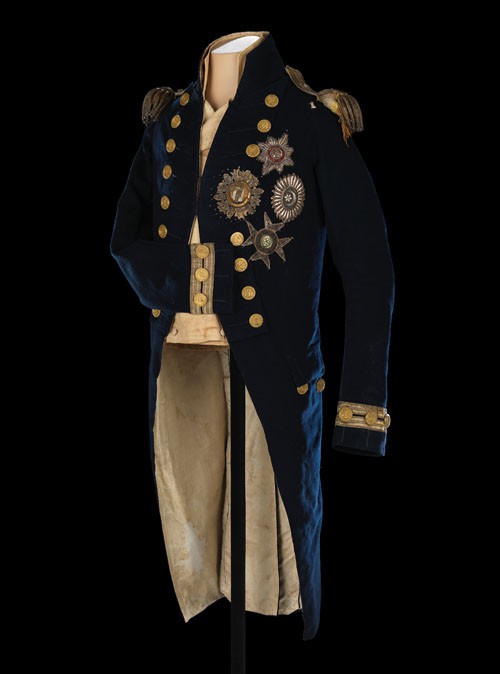As part of the exhibition “Napoleon et l’Europe” in 2013*, the Musée de l’Armée in Paris displayed various objects and memorabilia associated with famous figures from the Napoleonic era. Among these objects was the uniform which belonged to Alexander I of Russia (Moscow, the Kremlin), another which was worn by Francis I of Austria (Vienna, Heeresgeschichtliches Museum) as well as this one in which vice admiral Nelson died, which was loaned for the first time outside the United Kingdom by the National Maritime Museum in London.
This uniform has a turned-down collar, corresponding to the Royal Navy regulations of 1795-1812. It is matched with a pair of epaulettes decorated with the two stars that distinguuished a vice admiral of the Royal Navy. The uniform consists of other elements, also kept at the National Maritime Museum; notably a black velvet collar, a fancy waistcoat in white cotton, button-down breeches in white woollen serge and a pair of cotton and wool stockings. Aside from the quality of the materials and the production of the uniform, which distinguished the officers, it also has other distinctly unique features. Nelson had lost his right arm at Santa Cruz de Tenerife on 22 July 1797, and accordingly the right sleeve of the jacket is only lined to the elbow, and is equipped with a small loop that allows it to be crossed over the breast and fastened to a button. On the left sleeve and tails there are visible bloodstains, probably those of John Scott, Nelson’s secretary, who was killed just before him. Just like the damaged epaulette, the uniform is pierced by a hole at the left shoulder, left by the bullet which caused the vice admiral’s death on the bridge of the Victory.
The breast is embroidered with the insignia of four chivalric orders that Lord Nelson liked to wear. They are replicas, made especially for the uniform. At the top is the order of the Bath, received after the victory over the Spanish flotilla at Cape St Vincent (February 1797); on the right is the order of St Ferdinand and the order of merit, created in 1800 by the King of Naples, who Nelson supported during the war against France in 1798; at the bottom, the order of Saint Joachim, which united both Catholic and Protestant nobles; on the left, curiously sewn the wrong way round, is the Ottoman order of the crescent, instituted especially by Sultan Selim III to honour the victor of Aboukir (1-3 August 1798). Not being muslim, Nelson could not receive any of the orders of the Sublime Porte.
It has been suggested that these decorations could have made made the vice admiral a prime target, but bearing in mind the imprecision of the weapons, the movement of the boats and the men, the smoke, well, it would have been impossible to do more than see the bridge, and hope to hit an officer. According to the surgeon Beatty, who cared for Nelson in his last moments, the two shooters who were up on the masts of the Redoubtable at the moment of the vice admiral’s death were killed; the ensign Pollard was rewarded for having ‘avenged the death of Nelson’. This death gave cause for national mourning. The body, brought to London in a butt of sack, was interred at St Paul’s cathedral in the presence of over 15,000 people. The uniform and a number of other effects were given to Lady Hamilton, who gave them away to settle a debt in 1814. Prince Albert acquired them later for 150 pounds and donated them to Greenwich Hospital. As for the bullet that killed Nelson, it is now kept in the Royal Collection at Windsor.
E. Robbe, March 2013 (tr. A.M)
*This object was on display as part of the exhibition at the Musée de l’Armée in Paris, Napoléon et l’Europe, from 27 March 2013 to 14 July 2013.


